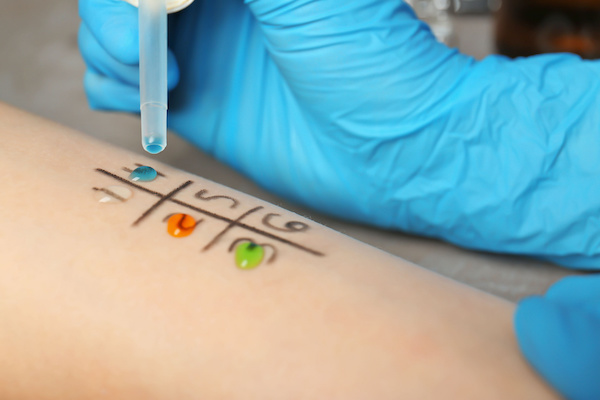Solving That Itch with a Scratch Test
- Category: Health
- Published: Monday, 07 November 2022 13:39
- Joanne Wallenstein
 The simple procedure, followed by a series of injections, can bring much-needed help to seasonal allergy sufferers.
The simple procedure, followed by a series of injections, can bring much-needed help to seasonal allergy sufferers.
The American College of Allergy, Asthma and Immunology estimates that more than 50 million people in the U.S. experience some type of allergic reaction each year. In many cases, those people frequently endure congestion, itchy eyes, a scratchy throat, and sinus-re¬lated issues. Adding to those frustrations may be the fact that they’re not even sure what they’re allergic to.
But answers, and relief, can be readily available through a scratch test, or prick test, to identify allergy triggers. The procedure, which is available onsite at Scarsdale Medical Group offices, involves a simple series of steps:
• The patient’s back or forearm is cleaned, after which a series of marks – typically around 60 – are made on it.
• A liquid extract is applied to each mark. The extracts contain proteins isolated from allergens such as ragweed, grasses, animal dander, dust mites, and mold.
• Using a needle, each mark is gently scratched to introduce the extract under the skin.
• After a brief wait, the marks are examined to see which ones develop a bump approximately the size of a mosquito bite, known as a “wheal,” with a corresponding red area, known as a “flare.”
• Using a ruler, each wheal is measured to see if any is longer than 4 millimeters – the length that indicates an allergic reaction.
All told, the entire procedure takes about 15 minutes. If the scratch test shows significant allergic reactions, a course of allergy shots is often the best treatment in providing significant relief.
Patients receive injections that contain a mixture of tiny amounts of their allergens. The shots are formulated at levels that stim¬ulate the immune system but do not cause a full-scale allergic reaction. With each visit, the patient is injected with higher concentrations of the allergens.
The allergy shots become effective very quickly. Within two weeks or so, many patients will feel relief from achy sinuses, postnasal drip, and itchy eyes. At about six months into the process, patients will be able to tolerate allergy shots in clinically effective strengths. The next step is to get maintenance injections weekly, eventually reducing their frequency to monthly.
Allergy skin testing can be done for all age groups to identify potential allergens. Indoor sensitization (dust and animal dander) can begin between six months and two years, while pollen sensitization develops between two and seven years old.
Knowing what you are allergic to can help you avoid those substance(s) in the future. And it’s not always a matter of merely solving recurring cases of the sniffles. Allergic conditions are one of the most common health issues affecting children in the U.S., and it is estimated that a severe allergic reaction (anaphylaxis) to food  generates 90,000 emergency room visits a year. Allergies are also the sixth leading cause of chronic illness in the U.S.
generates 90,000 emergency room visits a year. Allergies are also the sixth leading cause of chronic illness in the U.S.
Understanding what to avoid – and taking a 15-minute test to reach those conclusions – is, to coin a phrase, nothing to sneeze at.
Dr. Kirk Sperber is an allergist and immunologist at Scarsdale Medical Group in Harrison. or an appointment, call 914-723-8100.







